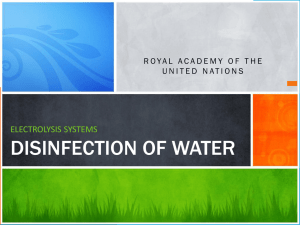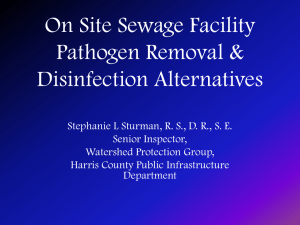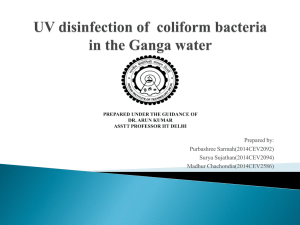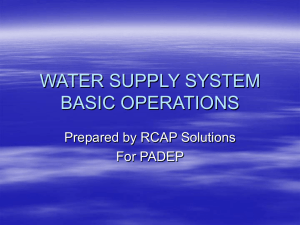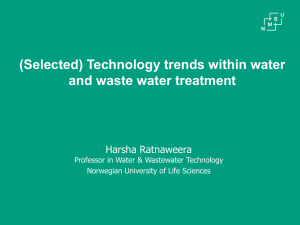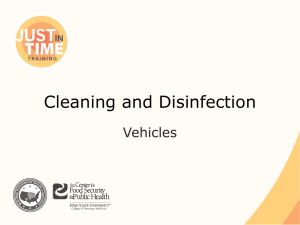Oxidation case studies
advertisement
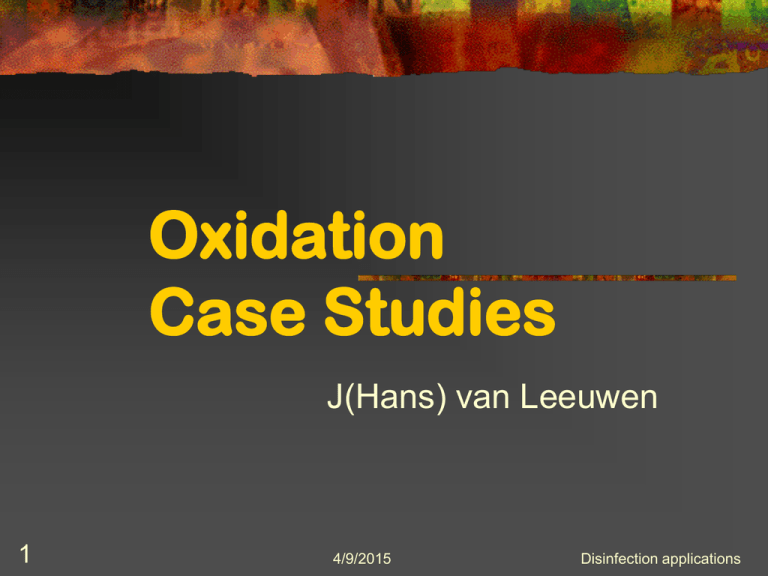
Oxidation Case Studies J(Hans) van Leeuwen 1 4/9/2015 Disinfection applications Introduction Summary and explanation Simple calculations Show some applications 2 4/9/2015 Disinfection applications DISINFECTION KINETICS Chick’s Law dN dt = -kN N is the number of microorganisms at time t, and k is a constant (dimension : t-1). This constant applies only for a fixed concentration of a certain disinfectant INTEGRATION OF CHICK’s LAW Integrating for N, N=No at t = 0 ln N/N0 = -kt N/N0 = e-kt 4 4/9/2015 Disinfection applications Watson’s Law Cnt = constant Simplified: Ct = constant Applies only for • a fixed rate of “kill” • a certain organism • a specific disinfectant 5 4/9/2015 Disinfection applications Example Ct value for ozone is 1.0 mgL-1min. We could achieve that with 1 mg/L ozone residual for 1 minute Or: 0.4 mg/L for 2.5 minutes 6 4/9/2015 Disinfection applications CHLORINE RESIDUALS Free – HOCl and OClCombined – NH2Cl, NHCl2 Total = Free + combined 7 4/9/2015 Disinfection applications CHLORINE REACTIONS WITH AMMONIA Cl2 + H2O HOCl + H+Cl- HOCl + NH3 NH2Cl + HOH HOCl + 2NH2Cl N2 + 3H+Cl- + H2O Net reaction: 2 x 2nd + 3rd : 3 HOCl + 2 NH3 N2 + 3H+Cl- + 3H2O 8 4/9/2015 Disinfection applications CHLORINE REACTIONS WITH AMMONIA Cl2 + H2O HOCl + H+Cl- HOCl + NH3 NH2Cl + HOH HOCl + 2NH2Cl N2 + 3H+Cl- + H2O Net reaction: 3 x 1st + 2 x 2nd + 3rd : 3 Cl2 + 2 NH3 9 N2 + 6H+Cl- 4/9/2015 Disinfection applications MEASUREMENT OF CHLORINE (OR CHLORAMINES) DPD – pink color develops KI solution – I-1 oxidized to I, forms I2 Color of DPD or I2 can be measured, or I2 titrated with FAS solution 10 4/9/2015 Disinfection applications formation Other oxidation reactions 11 4/9/2015 Disinfection applications DISINFECTION BYPRODUCTS • THMs - CHX3, e.g. CHCl3 • Chlorite and chlorate, ClO2ClO3• Bromoform - CHBr3 • Bromate - BrO3- 12 4/9/2015 Disinfection applications ClO2 made from Sodium Chlorite Acidification of Chlorite 5 ClO2- + 4 H+ 4 ClO2 + 2 H2O + ClOxidation of Chlorite by Chlorine 2 NaClO2 + Cl2 2 NaCl + 2 ClO2 Oxidation of Chlorite by Persulfate 2 NaClO2 + Na2S2O8 2 ClO2 + 2 Na2SO4 From Sodium Hypochlorite and Sodium Chlorite NaOCl + 2 NaClO2 + 2 HCl 2 ClO2 + 3 NaCl + H2O Electrochemical oxidation of chlorite ClO2- ClO2 + eDry chlorine/chlorite (laboratory method) NaClO2 + 1/2 Cl2 --> ClO2 + NaCl (solid) 13 4/9/2015 Disinfection applications OZONE PRODUCTION • Electron bombardment • UV irradiation at < 200 m • Electrolytically 14 4/9/2015 Disinfection applications 15 4/9/2015 Disinfection applications 16 4/9/2015 Disinfection applications 17 4/9/2015 Disinfection applications 18 4/9/2015 Disinfection applications 19 4/9/2015 Disinfection applications 20 4/9/2015 Disinfection applications 21 4/9/2015 Disinfection applications Corona Discharges in Ozone Generation 22 4/9/2015 Disinfection applications 23 4/9/2015 Disinfection applications 24 4/9/2015 Disinfection applications Large Ozone Generators 25 4/9/2015 Disinfection applications 1000 10000 100 10 1 0.1 Ozone concentration ppm Toxicity of ozone to humans 0.1 26 1 4/9/2015 10 100 1000 Exposure time (minutes) 10000 Disinfection applications COMPONENTS OF AN OZONATION SYSTEM INFLUENT OZONE GENERATOR AIR/OXYGEN PREPARATION AIR OZONE CONTACT CHAMBER OZONE DESTRUCTOR VENT OTHER OXYGEN APPLICATIONS EFFLUENT Alternative paths for enriched oxygen recycle 27 4/9/2015 Disinfection applications 28 4/9/2015 Disinfection applications BUBBLE COLUMN CONSTRUCTION DETAILS 29 4/9/2015 Disinfection applications 50m 50 m Deep Shaft Ozonation System 30 4/9/2015 Disinfection applications 0.8 0.7 OZONE RESIDUAL (mg/l) Ozone dose A 0.6 0.5 0.4 0.3 Ozone dose B 0.2 0.1 0 0 1 2 3 4 5 TIME (min) 6 7 8 9 10 Ozone Disinfection Pre-ozonation Raw Water Screening Clarification Filtration G A C Distribution Residual Disinfection 32 4/9/2015 Disinfection applications 33 4/9/2015 Disinfection applications 34 4/9/2015 Disinfection applications 35 4/9/2015 Disinfection applications OTHER USES OF OZONE IN WATER TREATMENT • • • • Iron and Mn removal Color removal Geosmin and 2-MIB Cyanotoxins – cylindrospermopsin, microcystin, anatoxin* • Microflocculation • Biodegradability *Produced by Cylindrospermopsis, Microcystis and Anabena genera 36 4/9/2015 Disinfection applications Scarce Water Resources near Mines 37 4/9/2015 Disinfection applications Further Applications of Ozone in The Water Technology Field • • • • • • • 38 Wastewater treatment Effluent disinfection Cooling water treatment Swimming pools Ozonated ice Ozonated air AOP (advanced oxidation processes) 4/9/2015 Disinfection applications Mine Water Cooling 39 4/9/2015 Disinfection applications Case Study: Mining Application 40 4/9/2015 Disinfection applications 41 4/9/2015 Disinfection applications 42 4/9/2015 Disinfection applications DUST 43 4/9/2015 Disinfection applications 44 4/9/2015 Disinfection applications 45 4/9/2015 Disinfection applications POSSIBLE INHIBITORS High temperatures Heavy metals Disinfectant byproducts or residues 46 4/9/2015 Disinfection applications 47 4/9/2015 Disinfection applications Ozonation Bubble Column Sand Filters 48 4/9/2015 Disinfection applications Oxidation of cyanides, thiocyanate and TOC in the Reclamation of Water in Steel Processing 49 BHP near Wollongong, Australia reuses wastewater after biological and activated carbon treatment Cyanides interfere with biological treatment and need to be lowered to 200 mg/L before activated sludge Cyanates are incompletely removed if over 250 mg/L 4/9/2015 Disinfection applications BHP Ozonation Investigations 50 Ozone was tested to observe efficacy to remove CN- and SCNOzone requirements due to competitive reactions observed Ozone needs to replace or enhance activated carbon treatment 4/9/2015 Disinfection applications CYANIDE REMOVAL FROM COG 51 4/9/2015 Disinfection applications CYANIDE REMOVAL FROM BHP 52 4/9/2015 Disinfection applications CYANATE REMOVAL FROM BHP 200,0 180,0 BHP 160,0 SCN, mg/L 140,0 120,0 100,0 80,0 60,0 40,0 20,0 0,0 0 53 250 500 750 Ozone consumed, mg/L 4/9/2015 1000 1250 Disinfection applications TOC AND COLOR REMOVAL FROM ACTIVATED SLUDGE EFFLUENT TOC mg/L or PCU 140 120 Color 100 80 60 TOC 40 20 0 0 10 20 30 40 50 60 70 Time, min 54 4/9/2015 Disinfection applications Cost Implications: CN 55 Capital cost of ozone installation $ 0.64 million Amortisation, maintenance operation $16,000 per month Present alternative, formaldehyde costs $ 7000 per month, more COD Ozone not cost effective 4/9/2015 Disinfection applications Cost implications: SCN- 56 Capital required $ 2.0 million Monthly costs $ 76 000 No other method SCN- removal There will be a much smaller risk in achieving treatment objectives Ozone not economical 4/9/2015 Disinfection applications SYNTHETIC ORGANIC REMOVAL BY INTEGRATED OZONOLYSIS/ ACTIVATED SLUDGE 57 4/9/2015 Disinfection applications CONVENTIONAL PREOZONATION + ACTIVATED SLUDGE - 58 AirAir 4/9/2015 Disinfection applications POST-OZONATION: Remove degradables first More Treatment required 59 4/9/2015 Disinfection applications Since ozonolysis results in biodegradable byproducts, more biological treatment required after post-ozonation This requirement can be resolved in two possible ways: ¶ another biological treatment stage ¶ recirculation to biological treatment 60 4/9/2015 Disinfection applications Biological treatment before and after ozonation Using a large ozonated recycle 61 Ozonated Recycle 4/9/2015 Disinfection applications 62 4/9/2015 Disinfection applications O3 THE SOLUTION INVESTIGATED 63 4/9/2015 Disinfection applications 64 4/9/2015 Disinfection applications Experimental Set-up Activated sludge with wastewater containing methylene blue ozonated 65 4/9/2015 Disinfection applications Results MeBl removal in ozonated activated sludge 95% vs. 40% in control COD removal in ozonated activated sludge 80.5% vs. 79.5% in control Better biomass settling 66 4/9/2015 Disinfection applications 67 Control Ozonated after settling mixed liquor 4/9/2015 Disinfection applications 68 4/9/2015 Disinfection applications 69 4/9/2015 Disinfection applications Conclusions 70 Ozone can be dosed within an activated sludge system for the ozonolysis of non-biodegradables Effect on biomass beneficial, if minimal Byproducts mainly biodegradable Economical integrated procedure 4/9/2015 Disinfection applications Pilot Scale Implementation at Van Diest Supply Company, Iowa 71 4/9/2015 Disinfection applications
